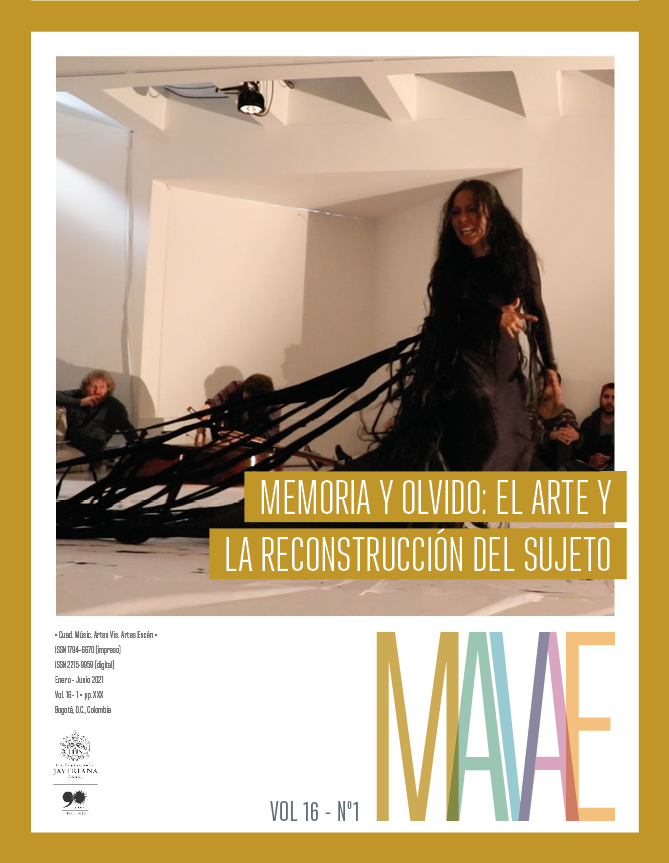Abstract
This paper presents some reflections on the paradox that emerges in some musicians between a facet of the musical experience that is spontaneous and anchored in enjoyment, and another that has somehow been “contaminated” by physical, emotional and mental marks, with an emphasis on fear in the relationship with music. We propose, based on our experience as musicians, educational managers, and teachers, that, in the formal music education system, we find the origin to several of these traces when it turns too much towards the product and towards the mastery of the means (techniques, analytical knowledge, etc.) as ends and not as means for sensitive expression. We find a friction between the institutional habitus and the idiosyncrasy of the musician in training who is permanently situated in an “interstitial tension” between the canon and his own inner world. We propose that this type of education focused on the technical and analytical mastery of canonical knowledge neglects the link of musicians with their own inner world and its expression through music, and thus the power of individual voices is wasted and the appearance of pathologies (physical, emotional, mental) that manifest themselves with different levels of intensity in people, is overlooked. Finally, we propose, as an alternative, a somatic perspective that provides light on the development of self-awareness integrating body, mind and emotion, and that favors the search for one’s own voice in the artistic context of the musician in relation to himself, to others and to the life situations he goes through. A perspective in which a permanent question is at the center of the sense of the profession: Why do we make music?
Becker, Judith. 2004. Deep Listeners: Music, Emotion, and Trancing. Bloomington: Indiana University Press.
Bourdieu, Pierre. 1988. La distinción: Criterios y bases sociales del gusto. Madrid: Taurus.
Bourdieu, Pierre. 2011. Las estrategias de la reproducción social. México: Siglo XXI.
Castro Carvajal, Julia y Marta Uribe Rodríguez. 1998. “La educación somática: Un medio para desarrollar el potencial humano”. Educación Física y Deporte 20 (1): 31-43.
Cumming, Naomi. 2000. The Sonic Self: Musical Subjectivity and Signification. Bloomington: Indiana University Press.
Delgado, Camilo. 2019. “Hacia una pedagogía musical saludable: Reflexiones desde la experiencia autobiográfica de un flautista bogotano”. Tesis de maestría, Pontificia Universidad Javeriana.
Gabrielsson, Alf. 2011. Strong Experiences with Music: Music is Much More Than Just Music. Oxford: Oxford University Press.
Gouk, Penelope, ed. 2000. Musical Healing in Cultural Contexts. Londres: Routledge.
Grün, Anselm. 2010. Escuchadme y viviréis: La fuerza espiritual de la música. Bogotá: San Pablo.
Guevara Prieto, Julio César. 2018. “Aproximación al estudio de las subjetividades políticas en la clase individual de instrumento”. Tesis de grado, Pontificia Universidad Javeriana.
Hanna, Thomas. 1986. “What is Somatics”. Somatics: Magazine-Journal of the Bodily Arts and Sciences 5 (4): 4-8.
Hernández Salgar, Oscar Andrés. 2009. “Músicos blancos, sonidos negros: Trayectorias y redes de la música del sur del Pacífico colombiano en Bogotá”. Tesis de maestría, Pontificia Universidad Javeriana.
Joselovsky, Ariel. 2016. Origen de la ansiedad: Cómo frenar el síntoma frente a la ansiedad. Barcelona: Ediciones B.
Khan, Hazrat Inayat. 1996. The Mysticism of Sound and Music: The sufí Teaching of Hazrat Inayat Khan. Boston: Shambhala.
Koen, Benjamin D. 2008. Beyond the Roof of the World: Music, Prayer, and Healing in the Pamir Mountains. Oxford: Oxford University Press.
Mendivil, Julio. 2016. En contra de la música: Herramientas para pensar, comprender y vivir las músicas. Buenos Aires: Gourmet Musical.
Ochoa Escobar, Juan Sebastián. 2012. “La ‘práctica común’ como la menos común de las prácticas: Una mirada crítica a los supuestos que configuran la educación musical universitaria en Colombia”. Tesis de maestría, Pontificia Universidad Javeriana.
Quintero Quintero, Rocío de Pilar. 2020. “La música y mi depresión: Mirada introspectiva de mi relación con el repertorio desde micondición (trastorno depresivo recurrente)”. Tesis de grado, PontificiaUniversidad Javeriana.
Rincón Mesa, Diana Alejandra. 2019. “Con el pétalo de una nota”. Tesis degrado, Pontificia Universidad Javeriana.
Samper Arbeláez, Andrés. 2018. “The translation of cuatro learning in open and closed systems of transmission in Colombia: Towardsan aural/oral approach in higher education”. Tesis doctoral, University College London.
Santamaría Delgado, Carolina. 2007. “El bambuco, los saberes mestizos de la academia: Un análisis histórico de la persistencia de la colonialidad en los estudios musicales latinoamericanos”. Latin American Music Review 28 (1): 1-23
Small, Christopher. 1998. Musicking: The Meanings of Performing and Listening. Middletown: Wesleyan University Press.
Weintraub, Mauricio. 2016. Música y emociones: Una mirada integral del intérprete de música. Buenos Aires: El Aleph.
Zuluaga, Germán. 1991. “La música del chamán”. Ponencia presentada

This work is licensed under a Creative Commons Attribution 4.0 International License.
Copyright (c) 2021 Andrés Samper Arbeláez y Luis Fernando Valencia Rueda


